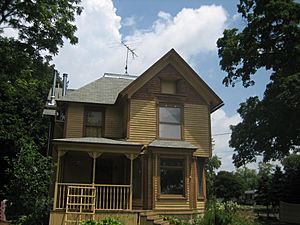Stephen Wright House facts for kids
Quick facts for kids |
|
|
Stephen Wright House
|
|
 |
|
| Location | 612 Chicago Rd., Paw Paw, Illinois |
|---|---|
| Area | less than one acre |
| Built | c. 1895-1906 |
| Built by | Stephen Wright, architect unknown |
| Architectural style | Queen Anne style |
| NRHP reference No. | 05000433 |
| Added to NRHP | May 22, 2005 |
The Stephen Wright House is a historic home in Paw Paw, Illinois, a village in Lee County, Illinois, USA. This beautiful house was built in the Queen Anne style. It was constructed between 1895 and 1906 by Stephen Wright, who bought and sold land in Paw Paw.
The house is located along an old trail once used by Native Americans and later by stagecoaches. There are other similar Queen Anne style homes nearby, which Stephen Wright might have also built. The Stephen Wright House was added to the U.S. National Register of Historic Places on May 22, 2005, because of its historical importance.
Contents
Where is the Stephen Wright House?
The Stephen Wright House is located on a road that was once a busy stagecoach trail. This trail connected Galena, Illinois to Chicago. Before that, the Potawatomi people used this same trail.
Today, this historic road is called County Route 10, or Chicago Road by local people. The house sits about 30 feet (9.1 m) back from the road. A picket fence surrounds the front lawn. There is also a garage behind the house. However, the garage is not considered part of the house's historic importance by the U.S. National Register of Historic Places. The land around the house is now smaller than it used to be. It is less than 1 acre (4,000 m²) today.
History of the Stephen Wright House
People believe that Stephen Wright, a land dealer from Illinois, built this house around 1895. Tax records from 1895 show that the land where the house stands was bought for US$100. Wright bought it from a local farmer who owned a lot of land in Paw Paw.
By 1906, records show the property was sold for a much higher price, $4,000. This suggests the house was built between 1895 and 1906. Stephen Wright still owned the property in 1900. But by 1906, he had sold it to Ezra Bretz. Mr. Bretz was from nearby Brooklyn Township. He lived in the house until he passed away in the 1940s.
After Mr. Bretz died, the house was changed into a duplex apartment. It stayed that way until the Paw Paw Bible Church bought it in the 1950s. The church changed it back into a single-family home. They used it as a parsonage, which is a home for a church minister. In 2002, the current owners bought the house. However, the Bible Church kept most of the original 4-acre (16,000 m²) property. There used to be a barn on the property, but it is no longer there.
What does the Stephen Wright House look like?
The Stephen Wright House is a great example of the late 19th-century Queen Anne style. It stands on a street with three other very similar houses. Because they look so alike, people think Stephen Wright, who bought and sold land, might have built all three houses. We know Stephen Wright built the house, but we do not know who designed it.
The house has a hip roof that slopes gently. It also has lower gables that cross over the main roof. The roof is covered with asphalt shingles. The very top of the roof has a flat area, about 14 feet (4.3 m) by 14 feet (4.3 m). This flat part gives the roof its "hipped" look. This type of Queen Anne roof, called "hipped roof with lower cross gables," is very common. You can see it on more than half of all Queen Anne style homes.
The entire house sits on a limestone foundation. The outside walls are covered with narrow wooden clapboards. The corner boards have a special trim that looks like Doric capitals. The front of the house has a large gabled section that sticks out from the main hip roof. Right under the roof's edge of this gabled part, there is decorative shingle work. This is another common feature in Queen Anne style architecture.
Why is the Stephen Wright House important?
The Stephen Wright House is an excellent local example of Queen Anne style architecture. The way the house is shaped and its fancy Queen Anne details make it a great example of this style. The Stephen Wright House was officially added to the U.S. National Register of Historic Places on May 22, 2005.




